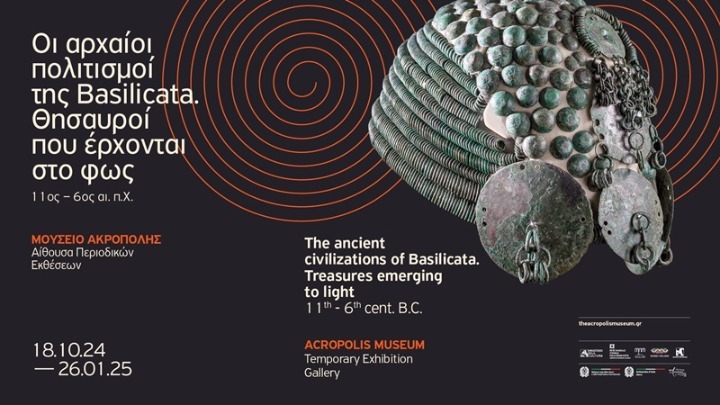Exhibition revealing ancient cultures from Basilicata, southern Italy, opens at Acropolis Museum

An exhibition on the ancient civilizations of Basilicata, southern Italy, which flourished from the 11th century BC to the 6th century BC, is opening to the public at the Acropolis Museum on Friday, October 18.
The unique exhibition was inaugurated by Culture Minister Lina Mendoni on Thursday evening.
"The Ancient Cultures of Basilicata: Treasures Coming to Light, 11th-6th c BC" will run through January 26, 2025 in the special exhibits section of tBahe Acropolis Museum. Entrance will be free to the public.
Over 300 objects will be shown, are selected from the storage areas of the National Archaeological Museum of Siritide (Greek Siris or Siritis), the National Archaeological of Metaponto, and the National Muusems of Matera. They highlight the history of the Basilicata area, which Greeks from ancient Peloponnese and the islands first came across while looking for land to settle in the part of Italy later named Magna Graecia.
The exhibition catalog has been issued in three languages (Greek, Italian, English), while the event is part of the program "Il racconto della bellezza" (A tale of beauty), a collaboration between Italy's Foreign Affairs and Culture Ministries that organizes periodical exhibitions at Italian Cultural Institutes globally. The initial exhibition was added to with more artefacts and came to the Acropolis Museum after an agreement with the Italian embassy and Italian Cultural Institute.
Press conference
Acropolis Museum General Director Nikolaos Stampolidis said at a press conference earlier in the day that he was very moved by the exhibition, "because once again, one understands the strong and brotherly bonds Greece has with Italy and Italy with Greece."
Stampolidis said the unique exhibition showed what happened in antiquity after the fall of Minoan and Mycenaean centers, particularly after the 12th and 11th centuries BC, until the Greeks started colonizing Asia Minor and Magna Graecia. "It is also a unique opportunity for our fragmented world of the 21st century, with all these economic crises, pandemics, and wars, to understand that the unity of these two peoples is a tangible example of civilization and mixing both in antiquity and today, for a collaboration and substantive promotion of both ancient and modern cultures today. For culture is not just the antiquities and the art works, culture is the relationships and associations of people."
Italian officials
Also speaking at the press conference were Director of the National Museums of Madera and of the Regional Directorate of National Museums of Basilicata, Annamaria Mauro, who spoke of the artifacts that were found in male and female burials and reveal the wealth and high status of personalities in their communities, as well as the cultural and trade relations with regions of the greater Adriatic, Etruria, and the Aegean.
Italian Culture Ministry General Director of Museums, Massimo Osanna, who spoke in fluent Greek, said that the region of Basilicata was marked by the routes of the rivers Sinni, Agri, Basento, and Bradano, which saw migrating Greek waves several times, and by the influences between cultures, as revealed through the objects found mostly in necropolises. The artifacts also revealed more about the ancient Italic people Oenotrians, who left no writing behind.
Also welcoming the exhibit was Filippo La Rosa, deputy director general of the Directorate General for Public and Cultural Diplomacy at the Italian Ministry of Foreign Affairs, who spoke of a narrative that began thousands of years ago and still remains one of fundamental importance.
VISITOR INFORMATION:
The exhibition is free to the public, but a free ticket must be issued at the Museum's entrance.
Tours of the special exhibit will begin on Tuesday, October 22. The program is available at the Museum's site, https://theacropolismuseum.gr/en/plan-your-visit (also available in Greek, French, Italian, and Spanish).
ITALIAN INSTITUTE
Concurrently, the Italian Cultural Institute in Athens will be showing at its facilities nearly 20 objects from the region of Basilicata. For more information, see https://iicatene.esteri.it/it/.

